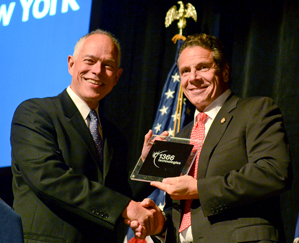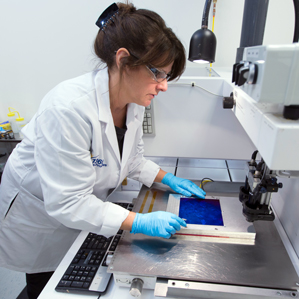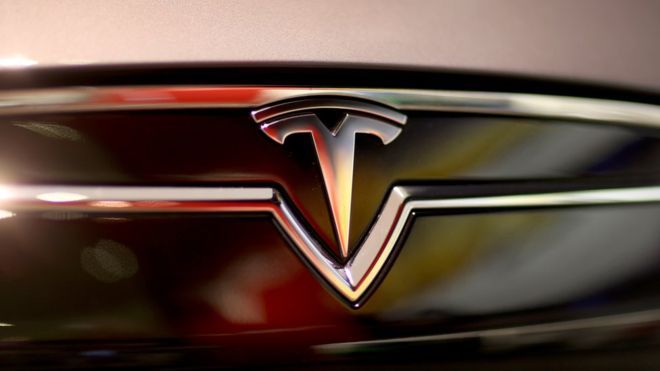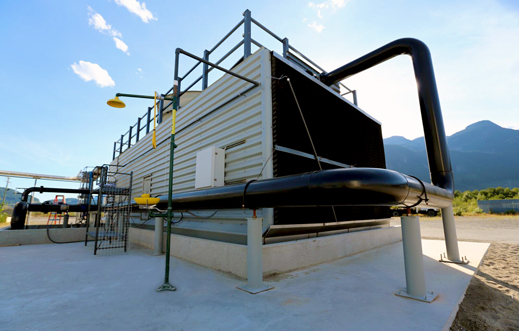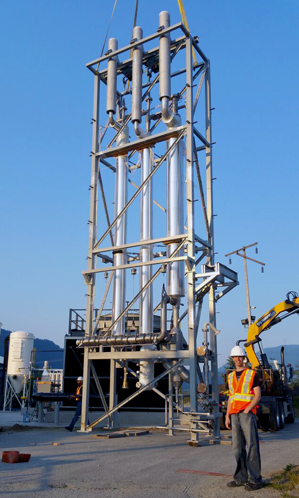| New method for making silicon wafers enables 1366 Technologies to survive and expand By Richard Martin on October 14, 2015 Why It MattersDeclines in component prices are making solar power nearly as cheap as coal-fired plants.
1366 CEO Frank van Mierlo presents New York governor Andrew Cuomo with a custom silicon wafer at an event announcing the company’s plans to build a commercial-scale factory in Genesee County. Solar wafer maker 1366 Technologies has survived the carnage in the U.S. solar manufacturing industry over the last five years. Now the company, which uses a novel technology for making the silicon wafers used in most solar cells, is embarking on its next phase, building a large manufacturing plant in upstate New York (see “Solar Survivor”). Founded by MIT professor Ely Sachs in 2008, the startup said last week that it will build its first commercial-scale factory in Genesee County, near Rochester. The plant will cost around $100 million and will initially produce about 50 million wafers annually, equivalent to 250 megawatts of power-generation capacity. Eventually, says CEO Frank van Mierlo, 1366 (which is named for the “solar constant,” the amount of solar energy that reaches Earth, in watts per square meter) hopes to reach three gigawatts of annual production at the Genesee plant, supplying silicon wafers to a solar industry that’s growing rapidly in North America, Europe, and the developing world. The Massachusetts-based company says it was lured to New York, as opposed to building in China, through a combination of state incentives, access to cheap hydro power, and the desire to make its products in the United States. The booming market for residential solar and the rising demand from developing countries including India, which has committed to building 100 gigawatts of solar capacity in the next seven years, is driving a comeback for solar manufacturing in the U.S. (see “India’s Energy Crisis”). SolarCity’s planned factory, also being built in upstate New York, will have a gigawatt of production capacity when fully operational at the beginning of 2017 (see “Paying for Solar Power”). Last month, the U.S. unit of China-based Seraphim Solar Manufacturing said it will open a new solar factory in Jackson, Mississippi, that will reach one gigawatt of capacity by 2018. In Hillsboro, Oregon, SolarWorld Americas is spending $10 million to expand its factory, currently the largest solar PV production facility in the Western Hemisphere.
A 1366 technician works in a lab at the company’s Bedford, Massachusetts, demonstration facility. Conventional factories produce silicon wafers via a multistep process of sawing, polishing, and slicing that wastes close to half of the silicon. Led by Sachs, who stepped aside as the company’s chief technology officer earlier this year, 1366’s team of several dozen engineers devised a way to make wafers directly from molten silicon, producing wafers for half the cost of traditional methods and dramatically reducing the amount of wasted silicon. The 1366 process also uses one-third the energy to produce each wafer. While the concept of producing wafers from molten silicon is not original to 1366, the company is the first to develop a production technology that can be expanded to commercial scale. In addition to a loan guarantee of $150 million from the U.S. Department of Energy that was made in 2011, the company will receive about $97 million in grants and tax incentives from the state of New York. Van Mierlo says 1366 has binding agreements for 60 percent of the plant’s production; he won’t name customers but says they are concentrated mostly China and Taiwan. However, 1366 still has to raise additional funds to build the Genesee facility. Van Mierlo says that “90 percent of that is secured at this point,” and that discussions are underway for the remaining $10 million. The state investment is part of New York governor Andrew Cuomo’s strategy of turning upstate New York into a major manufacturing hub for the solar industry. The state is investing $750 million to build the SolarCity plant, which it will lease back to the Silicon Valley company, essentially for free. Cuomo, who attended the 1366 launch event on November 7, called the 1366 announcement “a game changer” for New York’s tech sector and the U.S. solar industry. The track record of solar manufacturing companies built largely on public funding is not encouraging. But 1366 has survived so far in part because of its frugality. “The first line in a Dutch cookbook,” says van Mierlo, a U.S. citizen who was born in the Netherlands, “is ‘borrow an egg.’”
|
